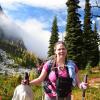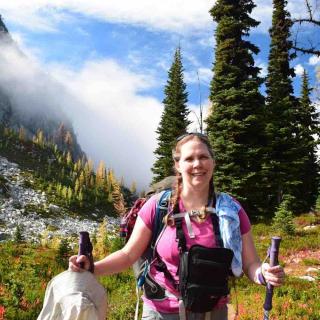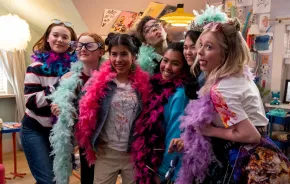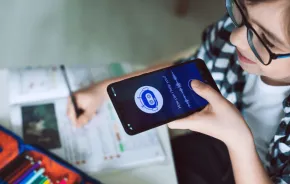 “Adventure is a mistake one makes on purpose. It springs from a naïve optimism that we can, in fact, do something that seems impossible, and from the stubborn perseverance to make it actually happen.” Erin McKittrick, Small Feet, Big Land
“Adventure is a mistake one makes on purpose. It springs from a naïve optimism that we can, in fact, do something that seems impossible, and from the stubborn perseverance to make it actually happen.” Erin McKittrick, Small Feet, Big Land
Erin McKittrick and her husband Brentwood "Hig" Higman have been exploring rolling tundra, lonely Arctic coastline, and icy glaciers. They’ve walked through riotous Alaskan summers, crisp autumn days colored by brilliant berry bushes and sideways-driving rain, and frigid, snow-piled winters. And they have carried out these treks with their two young children along for the ride.
Erin has written a book, Small Feet, Big Land, about their expeditions with kids and is in the Puget Sound region over the next few days to speak about that book (scroll to the bottom of the post for Washington State speaking dates, or find them here).
The book is an account of how Erin and Hig embarked on several journeys: the journeys in different parts of Alaska, the journey to build their family and integrate their children into their lives, and their journey to put down roots in the small town of Seldovia, Alaska.
Both scientists (Hig has a Ph.D. in Geology and Erin an M.S. in molecular biology), Erin and Hig integrate their adventures with their work in running the nonprofit Ground Truth Trekking, which is dedicated to educating the public about natural resource issues in Alaska.
Small Feet, Big Land concludes with the family spending two months exploring the stark and gritty Malaspina Glacier: Two months spent in a floorless tent, enduring rain and snow, melt water and seawater, with two children in diapers and only one toddler walking occasionally.

Erin describes their journey in clear and poetic language, with humor and insight and keen observations of their family and their environment.
Erin and Hig are giving talks about their book throughout Washington over the next few weeks, sharing incredible photos and videos, their favorite gear and stories.
After attending their recent presentation in Bellingham, Washington, I had a chance to ask Erin a few questions about their experiences.
Do you have a favorite piece of gear on your excursions?
The packraft, absolutely. It's a 5-pound boat that can fit in a pack but can easily handle any water we're willing to go in, and is durable enough for thousands and thousands of miles of travel. It was a game changer for us when we first got a pair of them -- turning rivers, lakes, and bays from obstacles into pathways.
I might give a different answer for the Malaspina Glacier expedition, though. There, the weather was so harsh and the kids were so little that I think our in-tent woodstove was my favorite.
How did you deal with diapers on the glacier? How did you stay clean? What about laundry?
We didn't stay clean! Alaska is cold, and we're never too excited about bathing in ice water, so we generally don't take full baths until we go through civilization. Sometimes, that's every week or two. Other times, like on Malaspina Glacier, that was two months! I did give the kids and I a bath in the packraft in the tent with stove-heated water in the middle of that time, but it was a lot of work, and we only did it once.
For diapers, we brought gDiapers. They have a system with a compostable insert, a reusable cloth cover, and reusable plastic liners. So we had to carry the dry inserts, but didn't have to carry wet or dirty ones out -- they can be dealt with just like adult waste. The outside pieces do sometimes get soiled, so we definitely did have to do laundry, but only once every two weeks or so. We did laundry in a big plastic odor-proof bag, with stove-warmed water and biodegradable soap, drying everything in the tent.
How did your kids handle having limited food options?
I think kids are the ones who want to eat the same things over and over again! Dinners and breakfasts have never been an issue. We bring noodles, instant mashed potatoes, quinoa, grits, or quick rice for a dinner base, then dress it up with a variety of spices, cheese, oil or butter, dried vegetables, and fresh wild greens if available. Breakfast was oatmeal with various dried fruits, or occasionally pancakes. Everyone is always hungry and our hot cooked meals were always a hit on the cold glacier. Especially the pancakes, and the butter. The kids would just gnaw on sticks of butter.
Snacks have proved more difficult. Things that can be eaten by a kid on the go but aren't too unhealthy are harder to come by, especially if you don't have time to make them all. Their favorites are granola bars (Katmai) and potato chips and chocolate (Lituya), and there are some complaints when they eat all of those and are stuck with nuts and fruit until the next resupply.
What are your biggest safety concerns while you are out adventuring, and how do you mitigate those?
The rational answer here is a little different than the emotional answer. The most dangerous things out there are small plane flights (getting to or from an adventure), and cold water (rivers and ocean crossings). For plane flights, all you can do is pick a good pilot and be careful of the weather you fly in. Mitigating the hazard of cold water is something we've thought a lot about over the years. Before we launch the rafts we're very careful in thinking through the conditions and the possible ways those conditions might change, making sure there's always an acceptable escape route if the wind comes up in a larger crossing, or that we're close enough to the edge to exit a river if a sweeper shows up around a bend. Of course, with kids too little to swim, we're more conservative about the conditions we'll go out in.

The emotional answer is that bears are the thing that's worried me much more after kids than it did before. But bears are a pretty small risk, and we've beefed up our bear-hazard mitigation until I'm quite satisfied with it. For tent safety, we store our food in odor-proof bags, and set up a portable electric fence (like the kind for livestock) around the tent that runs on a pair of AA batteries. For encounter safety, each adult has a can of pepper spray (the shampoo-bottle size they sell for bear deterrent) and sometimes a handheld flare. We make sure the kids stay close in areas where there could be a surprise bear encounter or if a bear is spotted. Over hundreds of encounters, we've never actually needed the spray.
I'm curious about your Friday kid hikes while you're at home in Seldovia. Can you tell me a bit about that group?
We started with a family tradition -- taking one day a week for the four of us to go out on a little adventure. About a year ago, we decided to open that up into a community event. We partnered with the Seldovia Village Tribe and the playgroup they run. This gave us access to a van to transport the kids, and a captive group of kids to start off with.
The basic pattern is that Hig and I pick the hike a couple days ahead of time, based on weather conditions, tides, and what we've done recently. Every Friday, we meet at 10:00 at the playgroup building, or 10:30 at the trailhead (for folks who are closer to it). Everyone brings a sack lunch, and we're usually out until somewhere around 3 or 3:30 p.m. Most of the kids are between 0 and 5 years old. Some come with parents, and some without.

We have about a dozen very local hikes we rotate between, most no more than a mile or two, mixed between beach walks and forest trails. We're always adding new ones. In the winter, the brush is covered by snow so we do more off-trail adventures, sometimes with little pairs of snowshoes for all the kids. There's a lot of time for snow sliding, tidepool exploring, looking at mushrooms, eating berries, etc... mixed in.
How do you and Hig resolve your differences while you're out in the wilderness? How has planning and doing these long and difficult journeys affected your relationship?
We travel extremely well together. But part of that is recognizing our own biases and weaknesses and how we need to work as a team. On the expedition planning scale, I'm often the person who has the bigger and bolder idea. While we're out there, Hig is the eternal optimist, and will come up with the craziest route plans and the most idealistic time estimates. I act here as the "Voice of Reason," thinking through all the potential flaws and risks in the idea. In the end, sometimes we do it, sometimes we don't, and I think the partnership of different personalities and different strengths is how we've managed to do so much, so safely, over so many years. On an expedition, we're a team, 24-7, and I think that's an experience few families get in everyday life. It makes us stronger.
How can you afford to take these long trips?
Freedom is one of our highest priorities. Higher than, say, indoor plumbing. :) We've designed a life to have very low costs, and very few scheduled commitments. We own our yurt and land (this shared with Hig's mother) outright, so have no housing costs, and only electricity and internet as regular bills.

These are nearly nothing while we're not at home. Our work is all part time, flexible and contract-based (we do some work for an environmental consulting firm), so we can choose not to work at all for months on end without losing a job. Once you have the freedom, the trips themselves are relatively cheap. Most of the cost is just food.
Most of us will not be taking our kids on long excursions in Alaska. Is there anything you'd like to pass on to parents in the city about what we CAN do?
The kids don't know if they're deep in the Alaskan wilderness, or in a pocket of woods much nearer the city. But I think all kids need to run, explore and discover some place real — in a natural environment that hasn’t been designed just for them. They need to imagine and observe. To feel their own strength and power in the face of the difficulties and discomforts that come along with nature.
I think the world needs it too. It needs people who know both how to plug in and unplug. To talk and to observe. Who realize that they can thrive in situations far beyond what they ever imagined.

Of course, you think I’m talking about the kids here. Which I am. But I’m talking just as much about the parents. Parenthood can feel so overwhelming and intimidating, that sometimes it can suck you right “into the box” of doing exactly what you think you’re supposed to do, or exactly what everyone else is doing — rather than what’s best for you, your family, or the world.
Do you have another trip in the works for the near future? What's your ultimate family dream adventure?
I love long expeditions. But I love my home too. So we tend to plan the longest expeditions (multi-month) to happen on an every other year schedule. This past spring and summer, we took the kids on an 800-mile foot and packraft journey around Alaska's Cook Inlet for 3.5 months. Next summer, we might stick closer to home, then head out again for another long journey, possibly in western Alaska, possibly in the Canadian Arctic.
At some point, I'd like to take each of the kids to their namesake places: Katmai Volcano in Katmai National Park and Lituya Bay on the Lost Coast of Alaska. I also have a grand scheme for us to eventually travel all of Alaska's coastlines (a lifetime goal!) as a family.
Speaking engagement dates
If you'd like to meet this fascinating family, find a full list of Washington State speaking dates on their site, with upcoming Puget Sound dates below.
- Wednesday, Oct. 30, Bainbridge Island Library, 1270 Madison Ave., Bainbridge, 7:30 p.m.
- Wednesday, Nov. 6, Lake Forest Park, Third Place Books, 17171 Bothell Way NE, Lake Forest Park, 7 p.m.
- Saturday, Nov. 9, Kirkland Public Library, 308 Kirkland Ave, Kirkland, 2 p.m.
- Monday, Nov. 11, Queen Anne Books, 7 p.m.
- Wednesday, Nov. 13, Olympia's Timberland Library, 7:30 p.m.
- Thursday, Nov. 14, Kings Bookstore, Tacoma, 7 p.m.
 About the author: Jennifer Johnson looks for any excuse to escape into nature with her children. She blogs about hiking with children at thehikermama.com.
About the author: Jennifer Johnson looks for any excuse to escape into nature with her children. She blogs about hiking with children at thehikermama.com.












